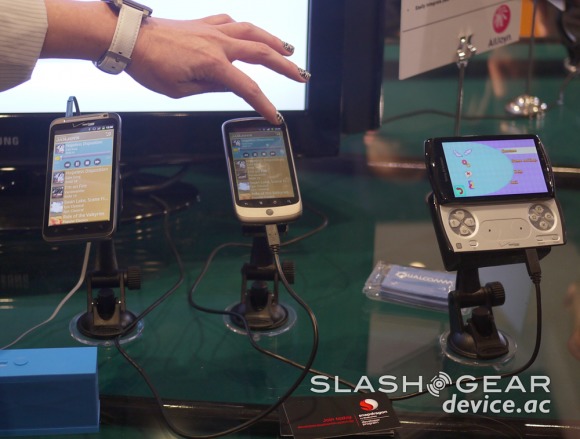
Earlier this month we were able to get a first hand look at an impressive technology from Qualcomm called AllJoyn. What is AllJoyn you ask? A peer-to-peer proximity based gaming, streaming, and sharing technology between devices such as Android phones and tablets. This makes device-to-device communication easy and simple for games, music, and anything else you can think of. Check out all our hands-on videos from CES 2012 below.
What makes AllJoyn special for both users and developers alike is all the work is already done before we even get these games or apps on our devices. The AllJoyn platform makes it dead simple for developers to integrate this service into their apps while developing — and even slotting them into already widely available games or applications.
Then from there all the work is already done and we can enjoy peer-to-peer live action gaming, music sharing/streaming, and more all without any connecting or pairing by the end user — AllJoyn does it all for you over WiFi or Bluetooth. The video below will explain more, not to mention detail how.
AllJoyn on Namco’s Pacman Kart
[vms 935234b174e62a07e53c]
Next up is a custom app designed specifically for AllJoyn called JamJoyn. This allows multiple devices the option to completely control and change music. One device is connected to the stereo but using AllJoyn multiple devices can access and control the music. Changing tracks, turning up the volume and more all with the peer-to-peer technology. I can see this causing problems with backseat DJ’s always switching the song on me, but could really be useful in my house.
The video demonstration below shows the HTC Thunderbolt (powered by Qualcomm of course) connected to a Jawbone Jambox playing music via JamJoyn. Then both the Thunderbolt, and the Nexus One beside it can both control the music. Pretty neat huh?
JamJoyn Music
[vms 736d88afc30c9212ccdd]
That isn’t all either. This same technology can be used for simple things such as drawing or Whiteboards. This could be particularly useful for educational settings both at home — or in the classroom. Being able to access and edit the same drawing board or whiteboard via AllJoyn. If I could add to the whiteboard in class without leaving my desk — that would be awesome. Take note of how this demonstration shows off how dead simple this really is, with no pairing or connecting needed by the end user. It’s seamless and all done inside the app.
WhiteBoard
[vms e5b08fcaafb50d03763c]
Last but certainly not least we have one more demonstration (my personal favorite) called Fight Game: Heroes. This is another AllJoyn powered game that is actually running on two Qualcomm S4 developer tablets being played peer-to-peer over 4G LTE. We do have this streaming via HDMI to a larger TV for the demonstration for a better view.
Your humble narrator (me) on the right vs our good friend Chris Burns on the left battling it out boxing style. showing off peer-to-peer gaming on a few developer tablets I quickly get the jabs and kicks down and knock out my opponent in the first round. Winnah!
Fight Game: Heroes
[vms d5e5848d6ec70e584e62]
We’ve seen this awesome technology from Qualcomm in the past but things are starting to finally take shape and show us just how impressive and useful this all can be for the world of mobile — especially for Android and the wide array of devices running on Qualcomm Snapdragon processors. Developers you can start thinking about what or how you want to use this technology now, and we’ll be sure to follow and update as we hear more from AllJoyn and Qualcomm.










Maybe it is just me, but I might just rather use my money to buy an actual PS3, I love Samsung phones, but sometimes the upgrades are unnessary.